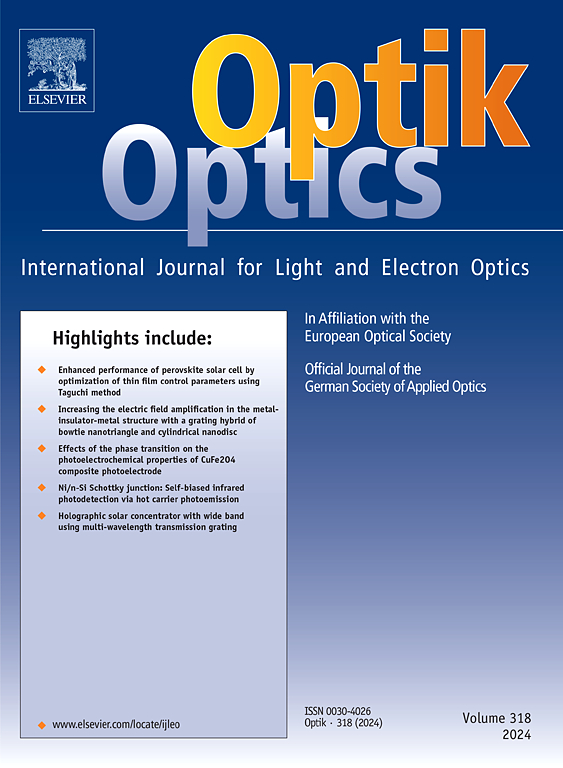Compact frequency-reconfigurable slot patch antenna with gain enhancement via metasurface integration
IF 3.1
3区 物理与天体物理
Q2 Engineering
引用次数: 0
Abstract
This work presents a frequency-reconfigurable slot antenna (FRSA) design that features a rectangular patch with a longitudinal slot on the ground plane, connected to eight vertical slots for basing. The proposed FRSA includes seven ideal switches (labeled w1–w7) positioned along the longitudinal slot, facilitating its reconfigurable functionality. By toggling these switches ON and OFF, the antenna operates in nine different modes. A single-layer metasurface reflector (MSR) was integrated below the FRSA to enhance the antenna's gain and directivity. The proposed MSR consists of a 2 × 2 array with a unit cell (UC) size of 18.25 mm× 15.025 mm, optimized to produce a center-operating frequency. The MSR achieves a stopband transmission coefficient (S21) below −10 dB and exhibits a linear reflection phase within the bandwidth of 3.30 ─ 5.96 GHz, nearly encompasses the FRSA frequency tuning range 3.05 – 5.16 GHz. Combining the FRSA and MSR significantly enhanced performance. The gain improved by 2.49 dB overall, rising from 3.14 dB to 5.63 dB in the lower band and from 5.25 dB to 5.38 dB in the upper band. Varying the FRSA and MSR gap enabled more gain optimization, enabling the gain to range from 3.93 dB to 6.09 dB. The FRSA with MSR covers an operating frequency range of 3.05 GHz to 5.24 GHz and supports operation at 3.05 GHz, 3.38 GHz, 3.98 GHz, 4.06 GHz, 4.34 GHz, 4.70 GHz, 4.74 GHz, 4.80 GHz, and 5.24 GHz. The proposed FRSA with MSR maintains a compact configuration, as the MSR's size matches the antenna's dimensions (0.38 λ₀ × 0.31 λ₀). The gap between the MSR and the antenna is only 20 mm (0.204 λ₀), where the wavelength (λ₀) corresponds to the minimum operating frequency of 3.05 GHz in free space. A prototype of the FRSA with MSR was fabricated and its performance was validated through measurements. The proposed antenna is well-suited for applications of S-band, C-band, and cognitive radio technologies.
通过超表面集成实现增益增强的紧凑频率可重构缝隙贴片天线
这项工作提出了一种频率可重构槽天线(FRSA)设计,其特点是一个矩形贴片,在接地面上有一个纵向插槽,连接到八个垂直插槽用于基座。拟议的FRSA包括沿纵向槽位的7个理想开关(标记为w1-w7),促进其可重构功能。通过打开和关闭这些开关,天线在九种不同的模式下工作。在FRSA下方集成了单层超表面反射器(MSR),提高了天线的增益和指向性。所提出的MSR由一个2 × 2阵列组成,其单元格(UC)尺寸为18.25 mmx 15.025 mm,优化后可产生中心工作频率。MSR的阻带传输系数(S21)低于−10 dB,并在3.30─5.96 GHz的带宽范围内呈现线性反射相位,几乎涵盖了FRSA频率调谐范围3.05—5.16 GHz。结合FRSA和MSR显著提高了性能。增益总体提高了2.49 dB,下频段从3.14 dB增加到5.63 dB,上频段从5.25 dB增加到5.38 dB。改变FRSA和MSR间隙可以实现更多的增益优化,使增益范围从3.93 dB到6.09 dB。MSR占地操作频率范围的FRSA 3.05 GHz 5.24 GHz,支持操作 3.05 GHz, 3.38 GHz 3.98 GHz, 4.06 GHz, 4.34 GHz, 4.70 GHz, 4.74 GHz, GHz 4.80和5.24 GHz。带MSR的拟议FRSA保持紧凑的配置,因为MSR的尺寸与天线的尺寸匹配(0.38 λ 0 × 0.31 λ 0)。MSR与天线之间的距离仅为20 mm (0.204 λ 0),其中波长(λ 0)对应于自由空间中最小工作频率3.05 GHz。制作了带有MSR的FRSA样机,并通过测量验证了其性能。该天线非常适合s波段、c波段和认知无线电技术的应用。
本文章由计算机程序翻译,如有差异,请以英文原文为准。
求助全文
约1分钟内获得全文
求助全文
来源期刊

Optik
物理-光学
CiteScore
6.90
自引率
12.90%
发文量
1471
审稿时长
46 days
期刊介绍:
Optik publishes articles on all subjects related to light and electron optics and offers a survey on the state of research and technical development within the following fields:
Optics:
-Optics design, geometrical and beam optics, wave optics-
Optical and micro-optical components, diffractive optics, devices and systems-
Photoelectric and optoelectronic devices-
Optical properties of materials, nonlinear optics, wave propagation and transmission in homogeneous and inhomogeneous materials-
Information optics, image formation and processing, holographic techniques, microscopes and spectrometer techniques, and image analysis-
Optical testing and measuring techniques-
Optical communication and computing-
Physiological optics-
As well as other related topics.
 求助内容:
求助内容: 应助结果提醒方式:
应助结果提醒方式:


